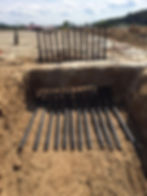
Commercial
LOOP INSTALLATION

Pond Loop
A Pond Loop consists of multiple coils piped together to serve the building. These coils will be piped together in "rafts" and sunk to the bottom of the lake/pond. This is the most cost effective way to achieve the benefits of a geothermal system. The drawback is that it takes a significant amount of land to build the pond for this system to be installed in if there is no existing pond.
Horizontal Bore
A Horizontal Bore loop field consists of a horizontal hole bored in the earth with 2 pipe connected threaded inside. The pipes will be installed deep enough to be below the frost layer, and deeper than ay obstacles in the space. This type of loop is a good choice where trenching is not an option due to surface obstructions and space.
Six-Pipe Loop
A 6-pipe loop field consists of a trench with 6 total pipes pinned on the floor and walls of the trench. The piping shall be deep enough to be installed below the frost line. The type of closed-loop field is cost effective, but will damage any existing landscaping above the piping.
Vertical Bore
A Vertical Bore loop field consists of vertical bores with 2 connected pipes inside. This hole is grouted to help achieve thermal connectivity. This type of loop is the best choice where horizontal space is limited.
DESIGN
Indiana Geothermal is a premier leader in the design of the geothermal loop fields. Kris Kyler, the President of Indiana Geothermal, is one of the few Certified GeoExchange Designers (CGD) in the Midwest; because of this, we believe we have a distinct advantage over our competitors. Indiana Geothermal has the correct tools to get the loop designed, drawn, and installed correctly the first time.















